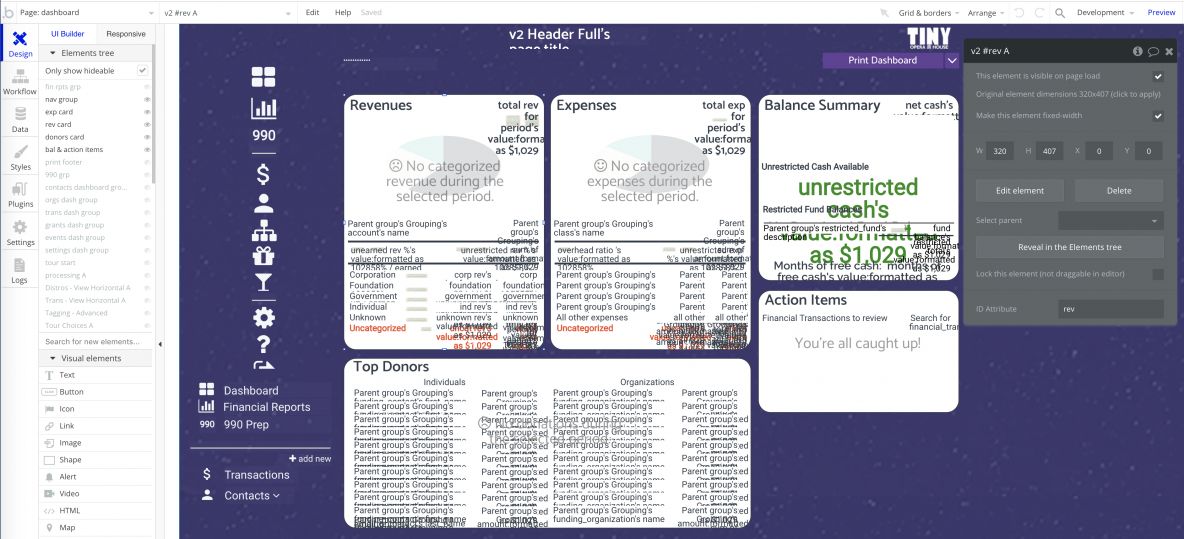It started back in January, with one of those “Hey you should talk to…” introductions. After a few coffee meets and getting to know each other, Hampton Dohrman and I decided to build Tiny Opera House in order to give the smallest of nonprofits a tool they could easily use to manage their finances and measure the impact of constituents. Hampton is a nonprofit veteran so we had the domain knowledge, and I was convinced I could build this thing, despite the fact that I have never considered myself “a coder.” So off I went, to build.
Rewind to 1995…
As that is when I first figured out that I could pull existing technology together to form solutions to problems, without building the entire thing from scratch. Web applications were in their infancy, or perhaps better, their toddler years…not recently born, but a long way from the mature systems of today. But how would I, with my odd mix of photographic and computer network training, build what I envisioned to be a one-stop-shop for small businesses to communicate with the external world using the technologies of the day: web, email, phone and fax. Without getting too deep into how that was done, the relevant piece for today is that I used a product called Tango (a Cold Fusion type product) to build the early versions of the web applications. Tango was a visual editor with drag-n-drop building that allowed me to connect with an Oracle database and bring functionality to otherwise static web pages. Those early web apps allowed me to get to market quickly, without having to hire a huge dev team. Getting to market brought in customers; customers bring revenue, revenue brings sustainability — especially when living through the dot-com bust that soon followed. As business grew, so did the technology demands, so eventually we moved the production environment to JAVA, continued to grow, and eventually had a nice exit.
The model worked…
So in building Tiny Opera House, I wanted to take the same approach — answer the big business questions, before investing heavy resources into application development. Twenty years ago, the big question was usually, “Can we build this?” Today, it has completely flipped to, “Can we acquire customers?” The technology we have at our disposal today is incredible, and cheap, so building the product is rarely the most difficult piece of building an online business — it is all about customer acquisition, so that is where the money should be spent.
I researched the various options and landed, and have stayed with, a hosted product called Bubble™ (https://bubble.is). Bubble™ provides an online editor that gives me the ability to produce fully functional, mobile responsive web applications without writing code. Databases, visual elements, API endpoints and connectors, a healthy plugin system and a vibrant developer community have made it possible to build our production application serving customers daily. No SQL statements, no thread management, no-code. It is drag-n-drop of visual elements (text, inputs, images, data displays, etc., combined with click-to-build workflow events and action that serve as the logic engine. User management is built-in, as is the ability to make secure Oauth connections to external resources. Snapshots allow versioning to any point in time, and the test and production environments give you the two basic versions needed for development. The shared hosted solution can be scaled allowing you to choose performance vs. cost, up to the point of moving to a dedicated instance meeting the needs of applications with tens of thousands of users. For Tiny Opera House, it’s early — so our monthly cost is a whopping $75. I fill a few gaps with some Python endpoints, but that’s really on the fringe — 95% of the application is built on Bubble™.
But here is the main point. From the time Hampton and I connected to build this thing, to the time we had our first customers, was about 2 months. This included a couple weeks of learning the basics of the Bubble™ platform as I had never used it.. Two guys, a few hundred dollars, and quickly we were interacting with customers, who are the only people that can answer the single most important question about your technology business — Does anybody even care?
Does anybody care that we can connect them easily with their bank account?
Does anybody care that we can track their restricted assets?
Does anybody care that we can show them how constituents are impacting their growth?
Does anybody care that we give them full financial statements?
Does anybody care, that for $10/month, we can ease the burden of managing their business, and get them back to doing what they love — changing the world?
I’ve seen (and have be actively involved with) too many businesses that get caught up in building “the next great…” and forget that in today’s environment, building things is not the challenge. I get it, building is fun! I wish I could just build cool stuff all day using the latest greatest widgets from the ever growing tech market. But that doesn’t sustain a business, revenue does. And revenue is hard to find.
We’re now on the second major version of Tiny Opera House. We’ve learned a lot by engaging with customers, who regularly tell us what they need and where we are falling shy of our own expectations. And we can continue to improve the product, and acquire more customers, because we haven’t dropped our life savings into building the product, yet the product delivers value every day. We’re helping this community of Big Tiny nonprofits have a positive impact on the world around us, and have big plans to make it even better!
Until next time,
–Ken
P.S. Let’s us know what you think by trying out the demo
